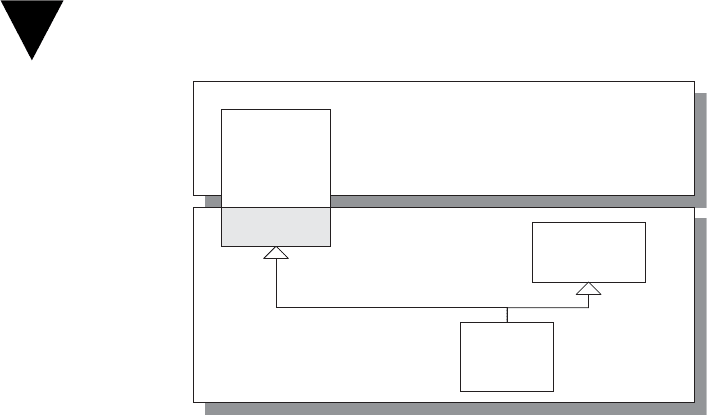Meszaros G. xUnit Test Patterns Refactoring Test Code
Подождите немного. Документ загружается.


88
Chapter 8 Transient Fixture Management
Most Fresh Fixtures we build are transient, so we will cover that case fi rst.
We will then come back to managing Persistent Fresh Fixtures in Chapter 9.
Building Fresh Fixtures
Whether we are building a Transient Fresh Fixture or a Persistent Fresh Fixture,
the choices we have for how to construct it are pretty much the same. The fi xture
setup logic includes the code needed to instantiate the SUT,
2
the code to put the SUT
into the appropriate starting state, and the code to create and initialize the state of
anything the SUT depends on or that will be passed to it as an argument. The most
obvious way to set up a Fresh Fixture is through In-line Setup (page 408), in which
all fi xture setup logic is contained within the Test Method. This type of fi xture can
also be constructed by using Delegated Setup (page 411), which involves calling
Test Utility Methods (page 599). Finally, we can use Implicit Setup (page 424),
in which the Test Automation Framework (page 298) calls a special
setUp method
we provide on our Testcase Class. We can also use a combination of these three
approaches. Let’s look at each possibility individually.
In-line Fixture Setup
In In-line Setup, the test handles all of the fixture setup within the body of
the Test Method. We construct objects, call methods on them, construct the
SUT, and call methods on it to put into a specific state. We perform all of
these tasks from within our Test Method. Think of In-line Setup as the do-
it-yourself approach to fixture creation.
public void testStatus_initial() {
// In-line setup
Airport departureAirport = new Airport("Calgary", "YYC");
Airport destinationAirport = new Airport("Toronto", "YYZ");
Flight flight = new Flight( flightNumber,
departureAirport,
destinationAirport);
// Exercise SUT and verify outcome
assertEquals(FlightState.PROPOSED, flight.getStatus());
// tearDown:
// Garbage-collected
}
2
This discussion assumes that the SUT is an object and not just static methods on a
class.

89
The main drawback of In-line Setup is that it tends to lead to Test Code Dupli-
cation (page 213) because each Test Method needs to construct the SUT. Many
of the Test Methods also need to perform similar fi xture setup. This Test Code
Duplication leads, in turn, to High Test Maintenance Cost (page 265) caused
by Fragile Tests (page 239). If the work to create the fi xture is complex, it can
also lead to Obscure Tests (page 186). A related problem is that In-line Setup
tends to encourage Hard-Coded Test Data (see Obscure Test) within each Test
Method because creating a local variable with an Intent-Revealing Name [SBPP]
may seem like too much work for the benefi t yielded.
We can prevent these test smells by moving the code that sets up the fi xture
out of the Test Method. The location where we move it determines which of the
alternative fi xture setup strategies we have used.
Delegated Fixture Setup
A quick and easy way to reduce Test Code Duplication and the resulting Obscure
Tests is to refactor our Test Methods to use Delegated Setup. We can use an Extract
Method [Fowler] refactoring to move a sequence of statements used in several Test
Methods into a Test Utility Method that we then call from those Test Methods. This
is a very simple and safe refactoring, especially when we let the IDE do all the heavy
lifting for us. When the extracted method contains logic to create an object on which
our test depends, we call it a Creation Method (page 415). Creation Methods
3
with
Intent-Revealing Names make the test’s pre-conditions readily apparent to the reader
while avoiding unnecessary Test Code Duplication. They allow both the test reader
and the test automater to focus on what is being created without being distracted
by how it is created. The Creation Methods act as reusable building blocks for test
fi xture construction.
public void testGetStatus_inital() {
// Setup
Flight flight = createAnonymousFlight();
// Exercise SUT and verify outcome
assertEquals(FlightState.PROPOSED, flight.getStatus());
// Teardown
// Garbage-collected
}
One goal of these Creation Methods is to eliminate the need for every test
to know the details of how the objects it requires are created. This stream-
lining goes a long way toward preventing Fragile Tests caused by changes to
3
When referenced via a Test Helper (page 643) class, they are often called the Object
Mother pattern (see Test Helper on page 643).
Building Fresh Fixtures

90
Chapter 8 Transient Fixture Management
constructor method signatures or semantics. When a test does not care about
the specifi c identity of the objects it is creating, we can use Anonymous Cre-
ation Methods (see Creation Method). These methods generate any unique keys
required by the object being created. By using a Distinct Generated Value (see
Generated Value on page 723), we can guarantee that no other test instance
that requires a similar object will accidentally use the same object as this test.
This safeguard prevents many forms of the behavior smell Erratic Test, includ-
ing Unrepeatable Tests, Interacting Tests, and Test Run Wars, even if we hap-
pen to be using a persistent object repository that supports Shared Fixtures.
When a test does care about the attributes of the object being created, we
use a Parameterized Anonymous Creation Method (see Creation Method). This
method is passed any attributes that the test cares about (i.e., attributes that are
important to the test outcome), leaving all other attributes to be defaulted by the
implementation of the Creation Method. My motto is this:
When it is not important for something to be seen in the test method,
it is important that it not be seen in the test method!
Delegated Setup is often used when we write input validation tests for
SUT methods that are expected to validate the attributes of an object argu-
ment. In such a case, we need to write a separate test for each invalid at-
tribute that should be detected. Building all of these slightly invalid objects
would be a lot of work using In-line Setup. We can reduce the effort and
the amount of Test Code Duplication dramatically by using the pattern
One Bad Attribute (see Derived Value on page 718). That is, we first call
a Creation Method to create a valid object, and then we replace one attri-
bute with an invalid value that should be rejected by the SUT. Similarly, we
might create an object in the correct state by using a Named State Reaching
Method (see Creation Method).
Some people prefer to Reuse Tests for Fixture Setup (see Creation Method) as an
alternative to using Chained Tests (page 454). That is, they call other tests directly
within the setup portion of their test. This approach is not an unreasonable one as
long as the test reader can readily identify what the other test is setting up for the
current test. Unfortunately, very few tests are named in such a way as to convey this
intention. For this reason, if we value Tests as Documentation, we will want to con-
sider wrapping the called test with a Creation Method that has an Intent-Revealing
Name so that test reader can get a sense of what the fi xture looks like.
The Creation Methods can be kept as private methods on the Testcase
Class, pulled up to a Testcase Superclass (page 638), or moved to a Test Help-
er (page 643). The “mother of all creation methods” is Object Mother (see Test

91
Helper). This strategy-level pattern describes a family of approaches that center
on the use of Creation Methods on one or more Test Helpers and may include
Automated Teardown (page 503) as well.
Implicit Fixture Setup
Most members of the xUnit family provide a convenient hook for calling code
that needs to be run before every Test Method. Some members call a method
with a specifi c name (e.g., setUp). Others call a method that has a specifi c annota-
tion (e.g., “@before” in JUnit) or method attribute (e.g., “[Setup]” in NUnit). To
avoid repeating these alternative ways every time we need to refer to this mecha-
nism, this book simply calls it the setUp method regardless of how we indicate
this fact to the Test Automation Framework. The setUp method is optional or an
empty default implementation is provided by the framework, so we do not have
to provide one in each Testcase Class.
In Implicit Setup, we take advantage of this framework “hook” by putting all
of the fi xture creation logic into the setUp method. Because every Test Method on
the Testcase Class shares this fi xture setup logic, all Test Methods need to be able
to use the fi xture it creates. This tactic certainly addresses the Test Code Duplica-
tion problem but it does have several consequences. What does the following test
actually verify?
Airport departureAirport;
Airport destinationAirport;
Flight flight;
public void testGetStatus_inital() {
// Implicit setup
// Exercise SUT and verify outcome
assertEquals(FlightState.PROPOSED, flight.getStatus());
}
The fi rst consequence is that this approach can make the tests more diffi cult to
understand because we cannot see how the pre-conditions of the test (the test
fi xture) correlate with the expected outcome within the Test Method; we have to
look in the setUp method to see this relationship.
public void setUp() throws Exception{
super.setUp();
departureAirport = new Airport("Calgary", "YYC");
destinationAirport = new Airport("Toronto", "YYZ");
BigDecimal flightNumber = new BigDecimal("999");
flight = new Flight( flightNumber , departureAirport,
destinationAirport);
}
Building Fresh Fixtures

92
Chapter 8 Transient Fixture Management
We can mitigate this problem by naming our Testcase Class based on the test
fi xture created in the setUp method. Of course, this makes sense only if all of the
Test Methods really need the same fi xture—it is an example of Testcase Class per
Fixture (page 631). As mentioned earlier, several members of the xUnit family
(VbUnit and NUnit, to name two) use the term “test fi xture” to describe what
this book calls the Testcase Class. This nomenclature is probably based on the
assumption that we are using a Testcase Class per Fixture strategy.
Another consequence of using Implicit Setup is that we cannot use local vari-
ables to hold references to the objects in our fi xture. Instead, we are forced to
use instance variables to refer to any objects that are constructed in the setUp
method and that are needed either when exercising the SUT, when verifying
the expected outcome, or when tearing down the fi xture. These instance vari-
ables act as global variables between the parts of the test. As long as we stick
to instance variables rather than class variables, however, the test fi xture will
be newly constructed for each test case in the Testcase Class. Most members
of xUnit provide isolation between the fi xture created for each Test Method
but at least one (NUnit) does not; see the sidebar “There’s Always an Excep-
tion” (page 384) for more information. In any event, we should defi nitely give
the variables Intent-Revealing Names so that we do not need to keep referring
back to the setUp method to understand what they hold.
Misuse of the SetUp Method
When you have a new hammer, everything looks like a nail!
Like any feature of any system, the setUp method can be abused. We should
not feel obligated to use it just because it is provided. It is one of several code
reuse mechanisms that are available for our application. When object-oriented
languages were fi rst introduced, programmers were enamored with inheritance
and tried to apply it in all possible reuse scenarios. Over time, we learned when
inheritance was appropriate and when we should resort to other mechanisms
such as delegation. The setUp method is xUnit’s inheritance.
The setUp method is most prone to misuse when it is applied to build a Gen-
eral Fixture (see Obscure Test) with multiple distinct parts, each of which is
dedicated to a different Test Method. This can lead to Slow Tests (page 253)
if we are building a Persistent Fresh Fixture. More importantly, it can lead to
Obscure Tests by hiding the cause–effect relationship between the fi xture and
the expected outcome of exercising the SUT.
If we do not adopt the practice of grouping the Test Methods into Testcase
Classes based on identical fi xtures but we do use the setUp method, we should
build only the lowest common denominator part of the fi xture in the setUp

93
method. That is, only the setup logic that will not cause problems in any of
the tests should be placed in the setUp method. Even the fi xture setup code
that does not cause problems for any of the Test Methods can still cause other
problems if we use the setUp method to build a General Fixture instead of a
Minimal Fixture (page 302). A General Fixture is a common cause of Slow
Tests because each test spends much more time than necessary building the
test fi xture. It also tends to produce Obscure Tests because the test reader
cannot easily see which part of the fi xture a particular Test Method depends
on. A General Fixture often evolves into a Fragile Fixture (see Fragile Test)
as the relationship between its various elements and the tests that use them
is forgotten over time. Changes made to the fi xture to support a newly added
test may then cause existing tests to fail.
Note that if we use a class variable to hold the object, we may have crossed
the line into the world of Persistent Fresh Fixtures. Use of Lazy Setup (page 435)
to populate the variable, by contrast, carries us into the world of Shared Fix-
tures because later tests within the test suite may reuse the object(s) created
in earlier tests and thus may become dependent on the changes the other test
(should have) made to it.
Hybrid Fixture Setup
This chapter has presented the three styles of fi xture construction as strict alter-
natives to one another. In practice, there is value in combining them. Test auto-
maters often call some Creation Methods from within the Test Method but then
do some additional setup on an in-line basis. The readability of the setUp method
can also be improved if it calls Creation Methods to construct the fi xture. An
additional benefi t is that the Creation Methods can be unit-tested much more
easily than either in-line fi xture construction logic or the setUp method. These
methods can also be located on a class outside the Testcase Class hierarchy such
as a Test Helper.
Tearing Down Transient Fresh Fixtures
One really nice thing about Transient Fresh Fixtures is that fi xture teardown requires
very little effort. Most members of the xUnit family are implemented in languages
that support garbage collection. As long as our references to the fi xture are held in
variables that go out of scope, we can count on Garbage-Collected Teardown to do
all the work for us. See the sidebar “There’s Always an Exception” on page 384 for
a description of why the same is not true in NUnit.
Tearing Down Transient Fresh Fixtures

94
Chapter 8 Transient Fixture Management
If we are using one of the few members of the xUnit family that does not sup-
port garbage collection, we may have to treat all Fresh Fixtures as persistent.
What’s Next?
This chapter introduced techniques for setting up and tearing down an in-memory
Fresh Fixture. With some planning and a bit of luck, they are all you should need for
the majority of your tests. Managing Fresh Fixtures is more complicated when the
fi xture is persisted either by the SUT or by the test itself. Chapter 9, Persistent Fixture
Management, introduces additional techniques needed for managing persistent fi x-
tures, including Persistent Fresh Fixtures and Shared Fixtures.

95
Chapter 9
Persistent Fixture
Management
About This Chapter
In Chapter 8, Transient Fixture Management, we saw how we can go about
building in-memory Fresh Fixtures (page 311). We noted in that chapter that
managing Fresh Fixtures is more complicated when the fi xture is persisted either
by the SUT or by the test itself. This chapter introduces the additional patterns
required to manage persistent fi xtures, including both Persistent Fresh Fixtures
(see Fresh Fixture) and Shared Fixtures (page 317).
Managing Persistent Fresh Fixtures
The term Persistent Fresh Fixture might sound like an oxymoron but it is
actually not as large a contradiction as it might fi rst seem. The Fresh Fixture strat-
egy means that each run of each Test Method (page 348) uses a newly created fi x-
ture. The name speaks to its intent: We do not reuse the fi xture! It does not need
to imply that the fi xture is transient—only that it is not reused (Figure 9.1). Per-
sistent Fresh Fixtures present several challenges not encountered with Transient
Fresh Fixtures. In this chapter, we focus on the challenge posed by Unrepeatable
Tests (see Erratic Test on page 228) caused by leftover Persistent Fresh Fixtures
and Slow Tests (page 253) caused by Shared Fixtures (page 317).
What Makes Fixtures Persistent?
A fi xture, fresh or otherwise, can become persistent for one of two reasons. The
fi rst reason is that the SUT is a stateful object and “remembers” how it was used
in the past. This scenario most often occurs when the SUT includes a database,

96
Chapter 9 Persistent Fixture Management
Figure 9.1 A Fresh Fixture can be either transient or persistent. We can apply a
Fresh Fixture strategy even if the test fi xture is naturally persistent but we must
have a way to tear it down after each test.
but it can occur simply because the SUT uses class variables to hold some of its
data. The second reason is that the Testcase Class (page 373) holds a reference
to an otherwise Transient Fresh Fixture in a way that makes it survive across
Test Method invocations.
Some members of the xUnit family provide a mechanism to reload all classes
at the beginning of each test run. This behavior may appear as an option—a
check box labeled “Reload Classes”—or it may be automatic. Such a feature
keeps the fi xture from becoming persistent when it is referenced from a class
variable; it does not prevent the Fresh Fixture from becoming persistent if either
the SUT or the test puts the fi xture into the fi le system or a database.
Issues Caused by Persistent Fresh Fixtures
When fi xtures are persistent, we may fi nd that subsequent runs of the same Test
Method try to recreate a fi xture that already exists. This behavior may cause
confl icts between the preexisting and newly created resources. Although violat-
ing unique key constraints in the database is the most common example of this
problem, the confl ict could be as simple as trying to create a fi le with the same
name as one that already exists. One way to avoid these Unrepeatable Tests is
to tear down the fi xture at the end of each test; another is to use Distinct Gen-
erated Values (see Generated Value on page 723) for any identifi ers that might
cause confl icts.
Transient
Persistent
Immutable
Shared
Fixture
Shared
Fixture
Fresh
Fixture
Transient
Persistent
Immutable
Shared
Fixture
Shared
Fixture
Fresh
Fixture

Tearing Down Persistent Fresh Fixtures
Unlike fi xture setup code, which should help us understand the pre-conditions
of the test, fi xture teardown code is purely a matter of good housekeeping. It
does not help us understand the behavior of the SUT but it has the potential to
obscure the intent of the test or at least make it more diffi cult to understand.
Therefore, the best kind of teardown code is the nonexistent kind. We should
avoid writing teardown code whenever we can, which is why Garbage-Collected
Teardown (page 500) is so preferable. Unfortunately, we cannot take advantage
of Garbage-Collected Teardown if our Fresh Fixture is persistent.
Hand-Coded Teardown
One way to ensure that the fi xture is destroyed after we are done with it is to
include test-specifi c teardown code within our Test Methods. This teardown
mechanism might seem simple, but it is actually more complex than immediately
meets the eye. Consider the following example:
public void testGetFlightsByOriginAirport_NoFlights()
throws Exception {
// Fixture Setup
BigDecimal outboundAirport = createTestAirport("1OF");
// Exercise System
List flightsAtDestination1 =
facade.getFlightsByOriginAirport(outboundAirport);
// Verify Outcome
assertEquals(0,flightsAtDestination1.size());
facade.removeAirport(outboundAirport);
}
This Naive In-line Teardown (see In-line Teardown on page 509) will tear down
the fi xture when the test passes—but it won’t tear down the fi xture if the test
fails or ends with an error. This is because the calls to the Assertion Meth-
ods (page 362) throw an exception; therefore, we may never make it to the
teardown code. To ensure that the In-line Teardown code always executes, we
must surround everything in the Test Method that might raise an exception with
a try/catch control structure. Here’s the same test suitably modifi ed:
public void testGetFlightsByOriginAirport_NoFlights_td()
throws Exception {
// Fixture Setup
BigDecimal outboundAirport = createTestAirport("1OF");
try {
// Exercise System
List flightsAtDestination1 =
facade.getFlightsByOriginAirport(outboundAirport);
Managing Persistent Fresh Fixtures
97
